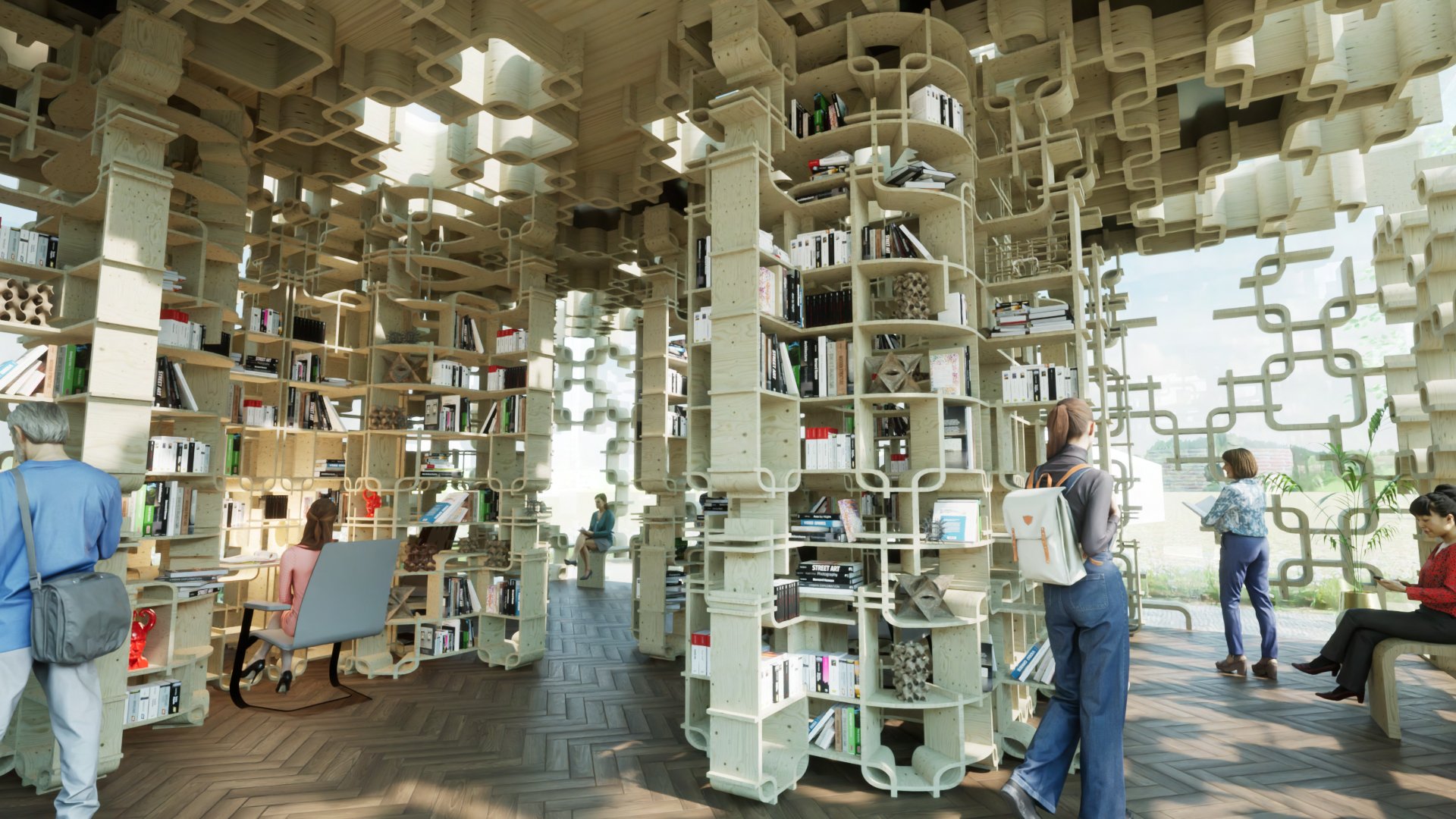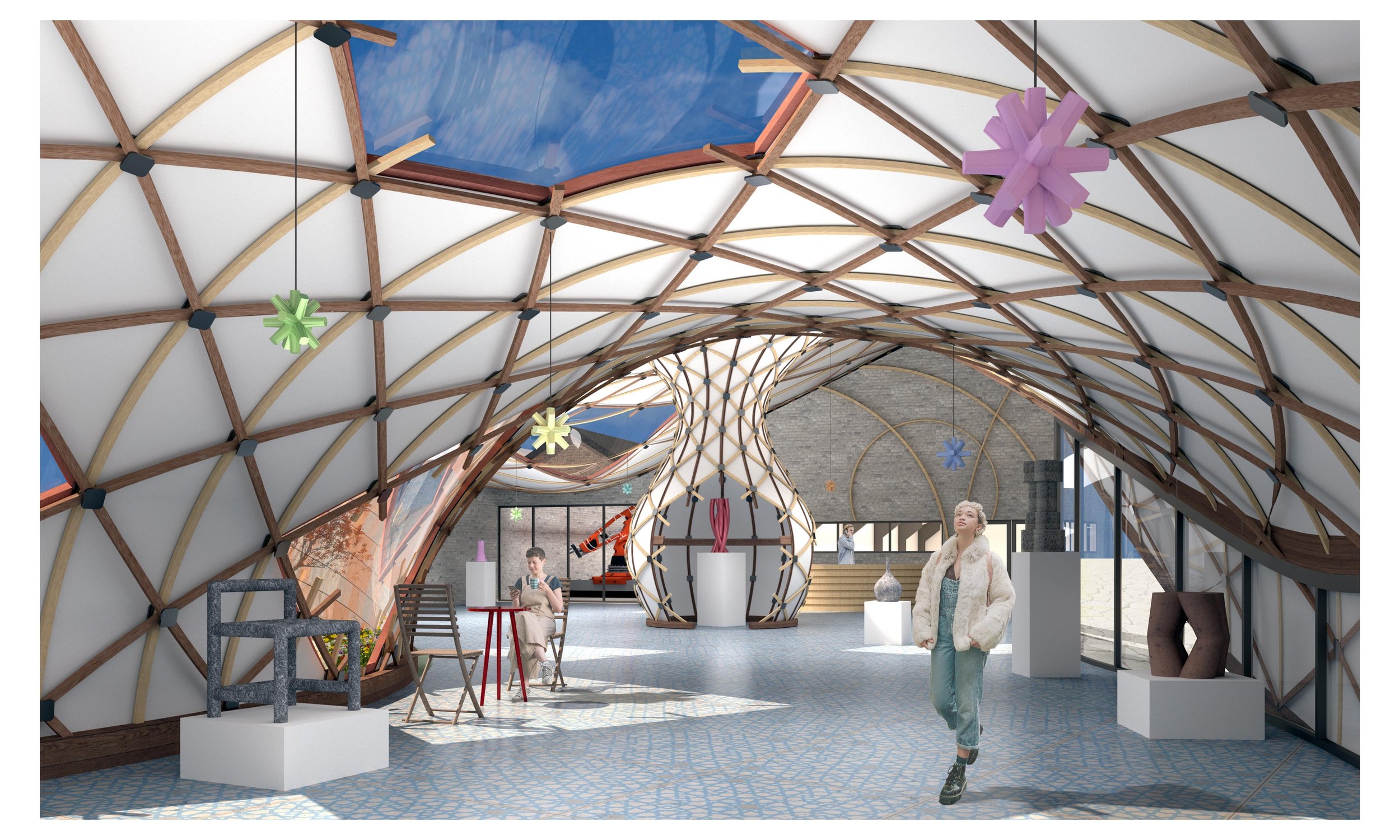DS2: Proto / Vernacular
Vernacular architecture is often associated with low-tech, specialised and labour intensive knowledge, transferred from generation to generation of self-builder via experiential, implicit methods (learning by doing). However, many modern methods of mass production and assembly have distanced the designer from the designed, divorcing building and place. With the rise of parametric design, digital fabrication and mixed-reality making are creating a revolution in the construction industry; putting the power of the digital directly into the hands of self-builders, makers and artists. How can these resources be tapped, to create a new digital vernacular, a renaissance of craft, which captures the intelligence of the past and the possibilities of the future? Given these advances, what will we talk about when we talk about vernacular architecture in the future?
-
Adam Holloway
Elliot Rogosin
Eliot Mayer
-
Callum Perry
Theadora Radcliffe
Fareed Fareed
Aled Evans
Hannah Green
Alec Parcell
Andrew Evans
Nivedita Sridhar
-
Patrycja Borak
Subrena Chhatwal
Mini Coker
Harry Court
William Dewar
Lindsey DuPell
Giselle Goh
Hin Fai Kung
Cory-John Lochrie
Neil Nageshkar
Tais Roberta Carvalho Raposo
Pedro Tello
Sonal Veerabhadra
Siti Zulaikha Binti Azmi
Cory Lochrie
Harry Court: The aim of this project was to build upon the land with only that was grown or collected upon the land, an extension of the operations that take place at Grymsdyke Farm. Comprising an extension to the original farm building, five self-build live workspaces and two multi occupancy faculty housing spaces.
Kung Hin Fai: The Bending Gridshell Courtyard in Bamboo Crafts Village, China - The project aims to encourage people to use the digital fabrication of CNC machines and robotic arms to improve the traditional knitting method. It attempts to use the bamboo weaving pattern to construct a gridshell structure courtyard in the Chinese village.
Giselle Goh: The project starts from Episode 1 Re-Cube, experimenting with the new way of interlocking system, continuously developing and applying it to the Playground-typed Library in Episode 2 Slot & Play…..
Harry Court: The aim of this project was to build upon the land with only that was grown or collected upon the land, an extension of the operations that take place at Grymsdyke Farm. Comprising an extension to the original farm building, five self-build live workspaces and two multi occupancy faculty housing spaces.
Sonal Veerabhadra: The programme for the project is a Fabrication School and Factory, where knowledge is constantly transferred through vision and interaction among different functions. The nature of the programme and its functions are dynamic, and require space for constant augmentation, which is served by the various abilities of the new brick – which is convened from the logic of Incan dry stone masonry combined with 3D interlocking geometries.
Pedro Tello: ‘Common ground’ empowers the character of earth and sets sustainable strategies through the application of vernacular knowledge using digital technologies. The project is situated in Grymsdyck Farm (Lacey Green, Buckinghamshire) a research facility with a fabrication workshop and living-working space for architects, artists and designers.
Giselle Goh: The project starts from Episode 1 Re-Cube, experimenting with the new way of interlocking system, continuously developing and applying it to the Playground-typed Library in Episode 2 Slot & Play…..
Mini Coker: This project explores the development of the vernacular form and materiality of the traditional mudbrick within the local context of Kafountine Senegal, through developing a new tectonic that pushes the thermal and spatial properties of the traditional building material.
Pedro Tello: ‘Common ground’ empowers the character of earth and sets sustainable strategies through the application of vernacular knowledge using digital technologies. The project is situated in Grymsdyck Farm (Lacey Green, Buckinghamshire) a research facility with a fabrication workshop and living-working space for architects, artists and designers.
Siti Azmi: Triggered by the current issue of endangered boat making industry in Pulau Durong [Duvong Island] which located in Terengganu, Malaysia. The aim is to create a Communitv Cen- tre and a traditional boat workshop where people can learn to build boat from the old people in Pula Duyong while learn- ing about Tanggam technique simultaneously. These two are very important Malaysia's heritage that have been struggling with challenges over recent year. The purpose of this proposal is going to raise the society's awareness regarding the current situation of traditional boat building production while provid- in a leaning hub as an archive to be preserved for the young- er generations. Also will be a place where locals can gather for their social activities. The design is an integration from the typical joinery that had been used by the Malavs as a part of the main construction of the building proposal.
Siti Azmi: Triggered by the current issue of endangered boat making industry in Pulau Durong [Duvong Island] which located in Terengganu, Malaysia. The aim is to create a Communitv Cen- tre and a traditional boat workshop where people can learn to build boat from the old people in Pula Duyong while learn- ing about Tanggam technique simultaneously. These two are very important Malaysia's heritage that have been struggling with challenges over recent year. The purpose of this proposal is going to raise the society's awareness regarding the current situation of traditional boat building production while provid- in a leaning hub as an archive to be preserved for the young- er generations. Also will be a place where locals can gather for their social activities. The design is an integration from the typical joinery that had been used by the Malavs as a part of the main construction of the building proposal.
William Dewar: Inspired by the ancient craft of steam bending, a method that uses steam to make timber pliable. This project explores the potential of applying the technique in the context of traditional timber gridshells.
Cory Lochrie
Mini Coker: This project explores the development of the vernacular form and materiality of the traditional mudbrick within the local context of Kafountine Senegal, through developing a new tectonic that pushes the thermal and spatial properties of the traditional building material.
William Dewar: Inspired by the ancient craft of steam bending, a method that uses steam to make timber pliable. This project explores the potential of applying the technique in the context of traditional timber gridshells.
Kung Hin Fai: The Bending Gridshell Courtyard in Bamboo Crafts Village, China - The project aims to encourage people to use the digital fabrication of CNC machines and robotic arms to improve the traditional knitting method. It attempts to use the bamboo weaving pattern to construct a gridshell structure courtyard in the Chinese village.
Subrena Chhatwal: Light the way explores the intersection of light, timber and arboreal spaces in the production of a forestry management school. The project is situated alongside Grymsdyke Farm, utilising both physical and academic learning in the betterment of UK forests.










![Siti Azmi: Triggered by the current issue of endangered boat making
industry in Pulau Durong [Duvong Island] which located in
Terengganu, Malaysia. The aim is to create a Communitv Cen-
tre and a traditional boat workshop where people can learn to
bu](https://images.squarespace-cdn.com/content/v1/5ee213897292cf2379bed0e3/adf9676b-1493-4adc-ab3e-caee8314a3cd/Siti+Azmi_Exhibition2.jpg)
![Siti Azmi: Triggered by the current issue of endangered boat making
industry in Pulau Durong [Duvong Island] which located in
Terengganu, Malaysia. The aim is to create a Communitv Cen-
tre and a traditional boat workshop where people can learn to
bu](https://images.squarespace-cdn.com/content/v1/5ee213897292cf2379bed0e3/47073baf-7dcb-4736-bb69-a7b1db5395a9/Siti+Azmi_Exhibition.jpg)





